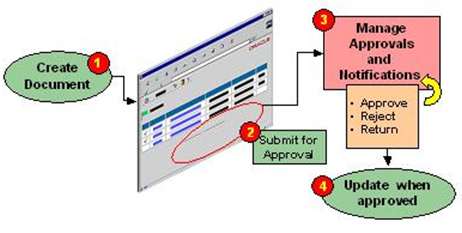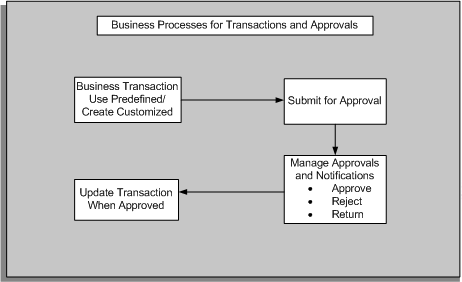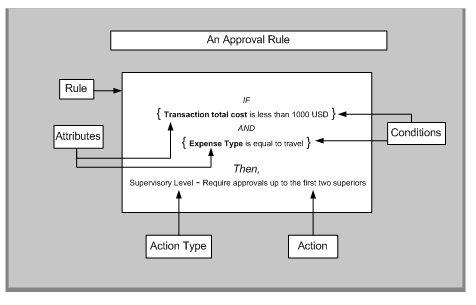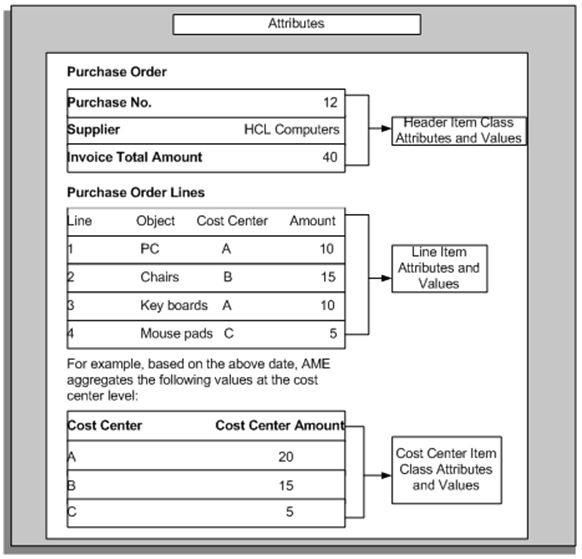Oracle Approvals Management

The purpose of Oracle Approvals Management (AME) is to define approval rules that determine the approval processes for Oracle applications. You can use AME to derive lists of approvers based on user defined rules and maintain a history of approvers statuses when :
- Authorizing expenses
- Transferring employess from one division/cost center to another
- Approving purchase orders with line or total order values
- Paying invoices
The following graphic illustrates the typical approval process used in an organization:

Approval Rules
An approval rule is a business rule that helps determine a transaction's approval process. Rules are constructed from conditions and actions. For example an approval rule can be as follows:
If the transaction's total cost is less than 1,000 USD, and the transaction is for travel expenses, then get approvals from the immediate supervisor of the person submitting the transaction.
The following graphic identifies the components of the approval rule:

The approval rule's if part consists of zero or more conditions, and its then part consists of one or more actions. A condition consists of a business variable (in AME, an attribute) and a set of attribute values, any one of which makes the condition true. An action tells AME to modify a transaction's approval process in some fashion. The conditions in the sample rule in the graphic refer to two attributes: the transaction's total cost, and the transaction's purpose. The sample rule's action tells AME to add the requestor's supervisor to the transaction's approver list.
AME enables you to define rules that express a wide variety of approval rules. For example, rules that:
• Require subject-matter-expert approval
• Require managerial approval
• Create exceptions for rules requiring managerial approval
• Substitute one approver for another in special cases
• Revoke a manager's signing authority in special cases
• Grant a manager extra signing authority in special cases
• Generate a production that assigns a value to a variable name such as the value digital certificate to the variable name eSignature.
• Send for-your-information notifications.
You can prioritize the approval rules. This enables you to apply rules of sufficient priority to any given transaction.
Transaction Types
An application that uses AME to govern its transactions' approval processes is termed an integrating application. An integrating application may divide its transactions into several categories where each category requires a distinct set of approval rules. Each set of rules is called a transaction type. Different transaction types can use the same attribute name to represent values that are calculated in different ways or fetched from different places. This allows several transaction types to share approval rules (thereby implementing a uniform approval policy across multiple transaction types). A rule use occurs when a transaction type uses a particular rule for a given time period, optionally at a given priority level.
AME enables you to define rules that express a wide variety of approval rules. For example, rules that:
• Require subject-matter-expert approval
• Require managerial approval
• Create exceptions for rules requiring managerial approval
• Substitute one approver for another in special cases
• Revoke a manager's signing authority in special cases
• Grant a manager extra signing authority in special cases
• Generate a production that assigns a value to a variable name such as the value digital certificate to the variable name eSignature.
• Send for-your-information notifications.
You can prioritize the approval rules. This enables you to apply rules of sufficient priority to any given transaction.
Transaction Types
An application that uses AME to govern its transactions' approval processes is termed an integrating application. An integrating application may divide its transactions into several categories where each category requires a distinct set of approval rules. Each set of rules is called a transaction type. Different transaction types can use the same attribute name to represent values that are calculated in different ways or fetched from different places. This allows several transaction types to share approval rules (thereby implementing a uniform approval policy across multiple transaction types). A rule use occurs when a transaction type uses a particular rule for a given time period, optionally at a given priority level.
